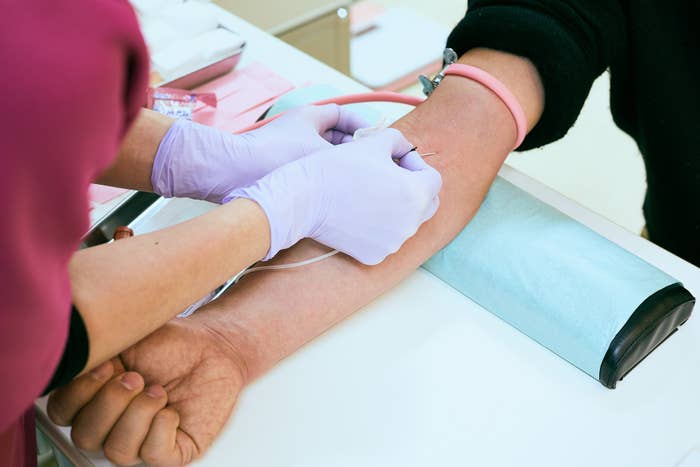
All adults should have their blood tested for hepatitis B — a vaccine-preventable virus that harms the liver — at least once in their life, regardless of their risk factors for the infection, according to new CDC recommendations released Thursday.
This is the first time the CDC has updated its guidance for HBV testing since 2008.
Previously, HBV screening was recommended only for those who faced increased risk for infection, such as people who inject drugs, pregnant people, and those with HIV. The virus spreads through contact with infected blood or bodily fluids.
The shift is based on evidence that shows risk-based testing alone cannot identify most people living with chronic HBV infection, more than half of whom don’t know they’re infected. Catching cases early on could lead to getting treatment sooner, which reduces the risk of liver damage, liver cancer, and death. It might also prevent HBV from being spread to others.
Children and teens under the age of 18 don’t have to be screened for HBV because infection prevalence is low and vaccination levels are high in the age group. However, kids who are at risk for HBV and/or did not get vaccinated as a baby should be tested.
(Most people are vaccinated against HBV during routine childhood immunizations; the most common scheduling is three doses administered over six months.)
The CDC also added three new groups of people who have increased risks of HBV infection to its risk-based testing recommendations: current or formerly incarcerated adults in a jail, prison, or other detention setting; people with a history of sexually transmitted infections or multiple sex partners; and people with a history of hepatitis C virus infection.
And now, anyone who requests HBV testing should receive it, the CDC said, “because many persons might be reluctant to disclose stigmatizing risks.”
People with increased risk of HBV infection that have not already been mentioned include:
- Infants born to pregnant people who are HBV positive
- People born outside the US in regions with a high prevalence of HBV
- People born in the US who weren’t vaccinated as infants and whose parents were born in regions with high rates of HBV
- Men who have sex with men
- People who live in the same home as others with a known HBV infection
- People who share needles or sexual contact with anyone with a known HBV infection
- People undergoing kidney dialysis treatment
- People with elevated levels of alanine aminotransferase or aspartate aminotransferase of unknown origin, which may indicate liver damage, infection, or cancer
In 2019, about 3,190 HBV infections were reported to the CDC, but after the agency adjusted for underreporting, that number jumped to 20,700.
About 580,000 to 2.4 million people are estimated to be living with HBV infection in the US, and about two-thirds of them might not be aware that they are. That’s because most people with acute or chronic HBV don’t experience symptoms and have no evidence of liver disease or injury.
HBV symptoms include fever, nausea, vomiting, abdominal pain, fatigue, loss of appetite, dark urine, joint pain, clay-colored poop, and jaundice (yellowing of the skin and eyes).
If people do develop symptoms, they typically emerge an average of three months after exposure to the virus. Acute infections tend to last for several weeks but can persist for up to six months.
Any activity that exposes you to the blood or bodily fluids of an infected person can spread the virus, such as pregnancy and delivery, sex, injection drug use, and the sharing of items like razors and toothbrushes.
The greatest risk for chronic infection occurs during the perinatal period, which includes the weeks right before and after birth; about 90% of infants with HBV end up developing chronic infection compared with only 2% to 6% of people who get infected as an adult.
Treatment for HBV infection involves several antiviral medications, including tenofovir (sold under the brand names Vemlidy and Viread), which is also used to treat HIV. Most people are able to recover from HBV without treatment, but about 1 in 20 people will go on to develop chronic HBV, in which the virus stays in the liver and over time can cause liver scarring (known as liver cirrhosis), liver failure, liver cancer, and death.
About 1,660 people died of HBV in 2019, involving mostly Asian and other Pacific Islander people, males, and people aged 65 to 74 years old. However, the CDC notes that HBV deaths are underreported. Overall, people with chronic HBV are 70% to 85% more likely to die prematurely than the general population.
Although the HBV vaccine is highly effective against infection, about 70% of adults in the US reported they were unvaccinated as of 2018, according to the CDC.
Generally, anyone who isn’t vaccinated against HBV and is at increased risk of infection should be tested periodically.
Recommended testing involves three separate laboratory exams that are capable of checking if a person has an active infection, a history of past infection that resolved but may be vulnerable to reactivation (this typically occurs in people with weakened immune systems), is susceptible to infection and needs vaccination, and is already vaccinated.
The current recommendation is that all adults aged 19-59 years old should be vaccinated against the virus if they haven’t been already.
